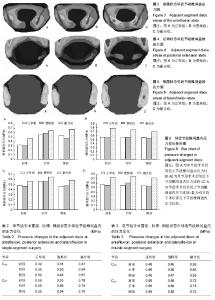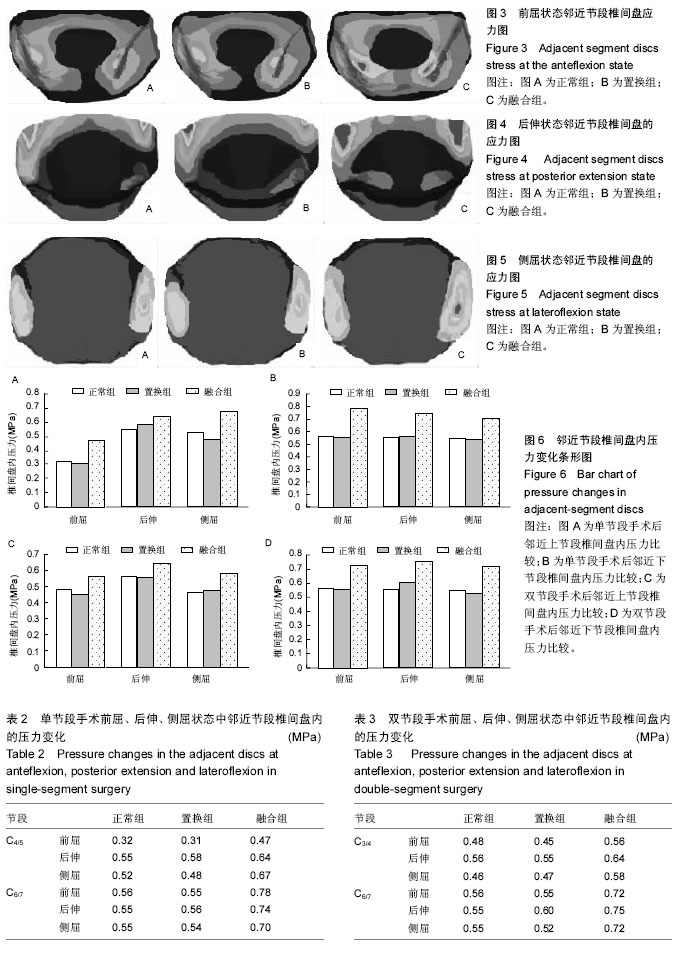| [1] 李斌,赵文志,陈秉智,等.人工椎间盘植入术后颈椎邻近节段生物力学变化的有限元分析[J].医用生物力学,2010, 25(2):94-99.
[2] Zhang QH, Teo EC, Ng HW, et al. Finite element analysis of moment-rotation relationships for human cervicalspine. Biomechanics. 2006;39:189-193.
[3] del Palomar AP, Calvo B, Doblaré M. An accurate finite element model of the cervical spine under quasi-static loading. Biomechanics. 2008;41: 523-531.
[4] 韩珂.人工颈椎间盘置换的三维有限元法生物力学研究[D].中南大学,2011.
[5] 姚女兆,黄曹,金大地.正常腰椎髓核MRI三维重建及其临床意义[J].中国现代医学杂志,2009,19(16): 2518-2520.
[6] 樊继宏.Mimics建模到Marc有限元分析的系统工程和实例[D].南方医科大学,2010.
[7] 方国芳,雷高,罗德民,等.三维重建仿真模拟手术辅助颈椎间盘置换[J].中国组织工程研究与临床康复,2011,15(13): 2283-2286.
[8] Watanabe S, Inoue N, Yamaguchi T, et al. Three-dimensional kinematic analysis of the cervical spine after anterior cervical decompression and fusion at an adjacent level: a preliminary report. Eur Spine J. 2012;21(5): 946-955.
[9] 薛翔.颈椎人工椎间盘置换术研究进展[J].中华实用诊断与治疗杂志,2014,28(3): 217-219.
[10] Bohlman HH, Emery SE, Goodfellow DB, et al. Robinson anterior cervical discectomy and arthrodesis for cervical radiculopathy. Long-term follow-up of one hundred and twenty-two patients. J Bone Joint Surg Am. 1993;75(9):1298-1307.
[11] Hilibrand AS. Carlson GD, Palumbo MA, et al. Radiculopathy and myelopathy at segments adjacent to the site of a previous anterior cervical arthrodesis. J Bone Joint Sung Am. 1999;81(4):519-528.
[12] Eck JC, Humphreys SC, Hodges SD. Adjacent-segment degeneration after lumbar fusion: a review of clinical, biomechanical, and radiologic studies. Am Orthop. 1999;28(6):336-340.
[13] Maldonado CV, Paz RD, Martin CB. Adjacent-level degeneration after cervical disc arthroplasty versus fusion. Eur Spine J. 2011;20(l3): 403-407.
[14] Katsuura A, Hukuda S, Saruhashi Y, et al. Kyphotic malalignment after anterior cervical fusion is one of the factors promoting the degenerative process in adjacent intervertebral levels. Eur Spine J. 2001;10(4):320-324.
[15] Gore DR, Sepic SB. Anterior discectomy and fizsion for painful cervical disc disease. A report of 50 patients with an average follow-up of 21 years. Spine. 1998; 23(19):2047-2051.
[16] DiAngelo DJ, Roberston JT, Metcalf NH, et al. Biomechanical testing of an artificial cervical joint and an anterior cervical plate. J Spinal Disord Tech. 2013; 16(4):314-323
[17] Baba H, Furusawa N, Imura S, et al. Late radiographic findings after anterior cervical fusion for spondylotic myeloradiculopathy. Spine. 1993;18(15):2167-2173.
[18] Rao RD, Wang M, McGrady LM, et al. Does anterior plating of the cervical predispose to adjacent segment changes? Spine. 2005;30(24):2788-2792.
[19] 刘雅普,夏虹,艾福志,等.人工颈椎间盘置换术后邻近节段退变情况的早中期随访[J].中国修复重建外科杂志,2012, 26(4): 385-389.
[20] 关涛,胡志伏,修磊,等.人工颈椎间盘置换术与颈椎前路减压融合术对相邻节段退变的影响[J].中国修复重建外科杂志,2014,28(9):1100-1105.
[21] Skeppholm M,Lindgren L,Henriques T,et al. The discover artificialdisc replacement versus fusion in cervical radiculopathy-a randomized controlled outcome trial with 2 year follow-up. Spine J. 2015;15(6): 1284-1294.
[22] 王自洲,柳达,付勤.人工颈椎间盘置换术与颈椎前路减压植骨融合术治疗颈椎病的效果比较[J].中国当代医药, 2013, 20(15):4-6.
[23] 游新茂,叶秀益,贾连顺,等.颈前路间隙减压人工颈椎间盘假体置换术治疗颈椎病15例疗效观察[J]. 现代实用医学, 2013,25(10):1114-1115.
[24] 娄纪刚,刘浩,龚全,等.单节段Prestige LP人工颈椎间盘置换术后置换节段活动度的影响因素分析[J].颈腰痛杂志,2015,36(1):20-24.
[25] 叶凯山,王栓科.人工颈椎间盘置换术治疗脊髓型颈椎病的疗效观察[J].临床骨科杂志, 2013, 16(6): 608-610.
[26] 郑建平,陈枫文,廉凯.人工颈椎间盘置换治疗颈椎病的近期疗效[J]. 临床骨科杂志,2014,17(6):739-740.
[27] 詹世强,昌耘冰,顾宏林,等.Discover人工颈椎间盘置换治疗颈椎间退变性疾病的早中期疗效及并发症分析[J].中国矫形外科杂志,2016,24(5):385-390.
[28] 张国强,张京新,鲁世保,等. 颈椎间盘置换治疗颈椎病术后相邻节段退变的临床观察[J].中国矫形外科杂志,2016, 24(13):1184-1188.
[29] Kim SW,Limson MA,Kim SB,et al.Comparison of radiographic changes after ACDF versus Bryan disc arthroplasty in single and bi-level cases. Eur Spine. 2009;18(2):218-231.
[30] 刘瑞端,肖荣驰,唐志宏,等.单节段颈椎间盘置换术对相邻颈椎节段退变的影响[J]. 中国骨与关节损伤杂志,2015, 30(5):452-455.
[31] Park JY,Kim KH,Kuh SU,et al. What are the associative factors of adjacent segment degeneration after anterior cervical spine surgery?Comparative study between anterior cervical fusion and arthroplasty with 5-year follow-up MRI and CT. Eur Spine J. 2013; 22(5):1078-1089.
[32] Cason GW, Herkowitz HN.Cervical intervertebral disc replacement. J Bone Joint Surg Am. 2013;95(3): 279-285.
[33] Chang UK, Kim DH, Lee MC, et al. Changes in adjacent-level disc pressure and facet joint force after cervical arthroplasty compared with cervical discectomy and fusion. Neurosurg Spine. 2007;7(1):33-39.
[34] Watanabe S, Inoue N, Yamaguchi T, et al. Three-dimensional kinematic analysis of the cervical spine after anterior cervical decompression and fusion at an adjacent level: a preliminary report. Eur Spine J. 2012;21(5): 946-955.
[35] 盛斌,黄象望,向铁城,等.人工颈椎间盘置换治疗前路颈椎减压融合术后相邻节段病的中期随访观察[J].中国脊柱脊髓杂志,2013,23(11):1050-1052.
[36] Demetriades AK,Ringel F,Meyer B,et al. Cervical disc arthroplasty: a critical review and appraisal of the latest available evidence. Adv Tech Stand Neurosurg. 2014; 41(4):107-129. |

